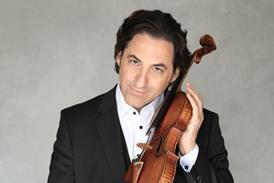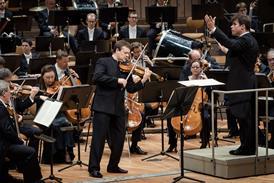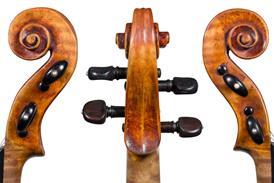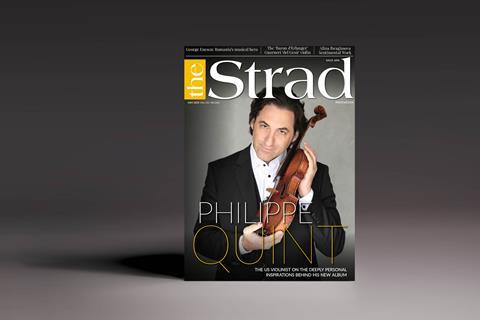Entrusted with the task of conserving one of the world’s most valuable violins, Bruce Carlson has made it easier to play, while taking it closer to how it would have looked to Paganini. In this article first published in 2004, he explains

One of my first tasks after I was appointed violin maker and conservator for the City of Genoa’s collection of historic violins in June 2000 was to examine the set-up of Paganini’s ‘del Gesù’ violin, the ‘Cannon’. The first thing that needed to be done was to plane the fingerboard, as it was worn and the hollow was deep and irregular, causing problems with intonation and fifths. After it was smoothed, a slightly higher bridge with a flatter curve was made, which gave bowing clearance in the treble C-bout that otherwise ran the risk of being struck by the bow. This bit of edge was worn, just as Paganini had left it, and we could not allow it to get worse, but this first adjustment was to be only an intermediate step.
On more than one occasion over the years, the violin has come under criticism from violinists for being difficult to play; this has generally been blamed on the setup rather than the violin itself. There are several reasons why the instrument is ‘difficult’. The body stop is longer than standard at 197.5mm and contributes to a vibrating string length which is longer than normal, at approximately 330mm. Other ‘del Gesù’ violins have a relatively short body stop (usually no longer than 191–192mm) and are often set up at less than the standard 328mm vibrating string length.
When I spoke to Vadim Repin while he was rehearsing on the ‘Cannon’ before a concert, he pointed out that when executing difficult passages in the higher positions he enjoys the extra space between notes. What can be said about this? Paganini was tall himself and perhaps he too enjoyed the extra room nearer the bridge. Certainly the physical makeup of the player can make a big difference. The non-standard string length does not require a large adjustment but some violinists adapt more quickly than others when switching from their own instrument.
The second problem is the inclination and shape of the neck. The scroll, neck and heel are of one piece and original to the instrument. The neck was lengthened (blocked up) at the heel a long time ago, a practice that was common and used either to save the original neck or when a neck graft was not considered necessary. The heel has been reshaped to a more pronounced modern curve, revealing the holes where the nails were located when it was originally fixed to the body by the maker.

When the neck was lengthened, a part of the original neck block was split away and the original nails were either removed or snapped off; a new piece of block was later glued on to replace the missing piece. With an X-ray examination of the area we discovered that the neck had been re-nailed in place a second time. Nevertheless, the neck is still slightly short by modern standards, at 128.5mm instead of the standard 130mm. This shifts all the notes from fourth position upwards towards the bridge or over the belly of the instrument.
If players are accustomed to using the heel of the neck or the shoulder as a reference then they find themselves playing slightly flat. The border thicknesses of the plates are quite robust and this combined with unusually high sides makes it more awkward to move into the upper positions with the left arm and hand. The ivory upper nut is also slightly too far back towards the volute, so not exactly in alignment with the end of the heel of the scroll. The first semitone is thus a little out of place.
-
The violin has come under some criticism from violinists for being difficult to play
The neck thickness and shape are unconventional, as one can see in the photograph of the silhouette showing the concave shape of the central portion of the neck (see p.1046). We have been advised by some ‘authorities’ that we should do a neck graft to replace the defective original neck, but this sort of solution is inconceivable on such a historically important instrument.
When the early photographs of the violin from around 1900 were uncovered in the archives in Genoa (see image), we were able to gaze upon the image of the violin essentially as bequeathed by Paganini. The old tuning pegs, bridge, tailpiece and strings were still in place.
One immediately noticed the sizeable disparity between the older images and the actual set-up on the violin. The Hill-style boxwood pegs and tailpiece suddenly seemed out of place.
For the sake of its historic importance, we decided to keep the visual aspect of the violin as similar as possible to that when played by Paganini, without compromising the possibility of its being played on special occasions by contemporary violinists.
Together with my two Genoese violin maker assistants, Alberto Giordano and Pio Montanari, we formulated a proposal to return the violin as near as possible to its original appearance as seen in the original photographs. The other important event occurred when the original accessories themselves were rediscovered. Armed with this new material it was possible for us to recreate the appearance of the ‘Cannon’ as left by the great violinist in 1840.
Reproductions of the pieces were made in resin from accurate castings taken of the originals. With these in hand, replicas of the original accessories were made. Once approval for our proposal was granted from the Italian Ministry of Cultural Heritage for Liguria, work began. Only four small variations were made relative to the original accessories.

The fingerboard was lengthened to 270mm rather than the shorter 262mm board made for Paganini in Vienna by Nicolaus Sawicki in 1828, which was found in the archives. The tailpiece was made shorter, the original being excessively long and therefore entirely too close to the bridge. The new end button, unlike the original, is in two pieces. The one-piece cap and central shaft can be removed, making it possible to see the soundpost through the hole in the lower block.
None of the original pegs still fits into the peg holes of the ‘Cannon’. This is not due to wear but to the intervention of another violin maker. Of the four pegs, three of the shafts are now very large and have a conicity close to the modern 1:30 (1mm change in diameter for every 30mm of the peg reamer length). Only the D peg has a smaller diameter and a conicity nearer 1:20, which is more commonly found in older instruments that have not been modified.
The fingerboard that was on the ‘Cannon’ came off easily and it brought the maple wedge with it. Photographs were taken, arching guides made and thicknesses recorded of the area of the table that before had been inaccessible underneath the fingerboard. The fingerboard to be replaced was of the modern type (thus the need for a wedge), while that of Sawicki was wedge shaped.
Allowance was made for the removal of the maple wedge, as it was not present in the old photographs. Because the string heights were slightly high relative to the preceding fingerboard we decided to move the fingerboard, at the bridge end, closer to the strings and to leave the end at the upper nut at the same height; in this way, a steeper neck projection was avoided. It also helps to make the violinist more comfortable in fast passages, where excess string height can impede performance.
The same ivory upper nut was used with the new board, without modification, and two bridges were tried, one modern for standard performance and the other an exact copy of the old bridge found in the museum archives.
There is no way to establish that what we now hear is what Paganini heard but it is a fascinating experiment into understanding the extraordinary musical companion of the violinist of all violinists.
















































No comments yet